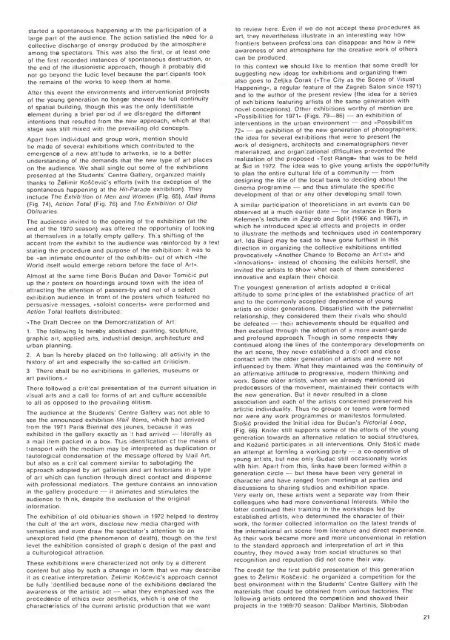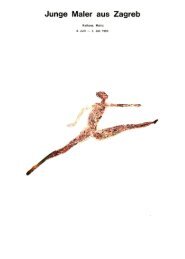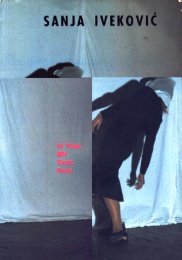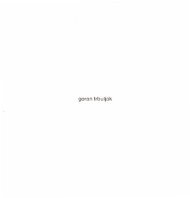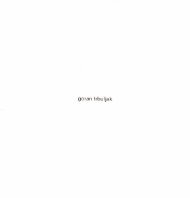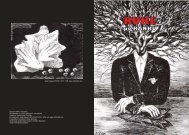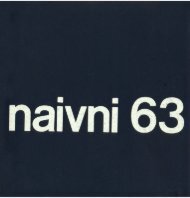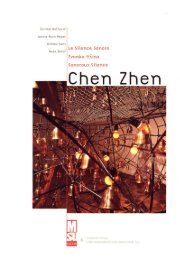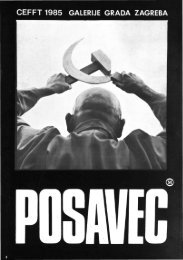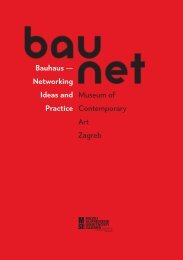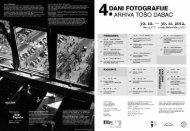The New Art Practice in Yugoslavia, 1966-1978
The New Art Practice in Yugoslavia, 1966-1978
The New Art Practice in Yugoslavia, 1966-1978
- TAGS
- practice
- yugoslavia
- www.msu.hr
You also want an ePaper? Increase the reach of your titles
YUMPU automatically turns print PDFs into web optimized ePapers that Google loves.
started a spontaneous happen<strong>in</strong>g w.th the participation of a<br />
large part of the audience. <strong>The</strong> action satisfied the need for a<br />
collective discharge of energy produced by the atmosphere<br />
among the spectators. This was also the first, or at least one<br />
9f the first recorded <strong>in</strong>stances of spontaneous destruction, or<br />
the end of the illusionistic approach, though it probably did<br />
not go beyond the ludic level because the partcipants took<br />
the rema<strong>in</strong>s of the works to keep them at home.<br />
After this event the environments and <strong>in</strong>terventionist projects<br />
of the young generation no longer showed the full cont<strong>in</strong>uity<br />
of spatial build<strong>in</strong>g, though this was the only identifiable<br />
element dur<strong>in</strong>g a brief perod if we disregard the different<br />
<strong>in</strong>tentions that resulted from the new approach, which at that<br />
stage was still mixed with the prevail<strong>in</strong>g old concepts.<br />
Apart from <strong>in</strong>dividual and group work, mention should<br />
be made of several exhibitions which contributed to the<br />
emergence of a new all tude to artworks, ie to a better<br />
understand<strong>in</strong>g of the demands that the new type of art places<br />
on the audience. We shall s<strong>in</strong>gle out some of the exhibitions<br />
presented at the Students Centre Gallery, organized ma<strong>in</strong>ly<br />
thanks to 2elimir Koevi's efforts (with the exception of the<br />
spontaneous happen<strong>in</strong>g at the Hit-Parade exhibition). <strong>The</strong>y<br />
<strong>in</strong>clude <strong>The</strong> Exhiblion of Men and Women (Fig. 65), Mail Items<br />
(Fig. 74), Action Total (Fig. 76) and <strong>The</strong> Exhibition of Old<br />
Obituaries.<br />
<strong>The</strong> audience <strong>in</strong>vited to the open<strong>in</strong>g of the exhibition (at the<br />
end of the 1970 season) was offered the opportunity of look<strong>in</strong>g<br />
at themselves <strong>in</strong> a totally empty gallery. Th's shift<strong>in</strong>g of the<br />
accent from the exhibit to the audience was re<strong>in</strong>forced by a text<br />
stat<strong>in</strong>g the procedure and purpose of the exhibit:on: it was to<br />
be »an <strong>in</strong>timate encounter of the exhibits» out of which »the<br />
World itself would emerge reborn before the face of <strong>Art</strong>».<br />
Almost at the same time Boris Buan and Davor Tomii put<br />
up the 'r posters on hoard<strong>in</strong>gs around town with the idea of<br />
attract<strong>in</strong>g the attention of passers-by and not of a select<br />
exhibition audience. In front of the posters which featured no<br />
persuasive messages, »soloist concerts, were performed and<br />
Action Total leaflets distributed:<br />
«<strong>The</strong> Draft Decree on the Demorcratization of <strong>Art</strong>:<br />
<strong>The</strong> follow<strong>in</strong>g is hereby abolished: pa<strong>in</strong>t<strong>in</strong>g, sculpture,<br />
graphic art, applied arts, <strong>in</strong>dustrial design, architecture and<br />
urban plann<strong>in</strong>g.<br />
A ban is hereby placed on the follow<strong>in</strong>g: all activity <strong>in</strong> the<br />
history of art and especially the so-called art criticism.<br />
3 <strong>The</strong>re shall be no exhibitions <strong>in</strong> galleries, museums or<br />
art pavilions..<br />
<strong>The</strong>re followed a critcal presentation of the current situation <strong>in</strong><br />
visual arts and a call for forms of art and culture accessible<br />
to all as opposed to the prevail<strong>in</strong>g élitism.<br />
<strong>The</strong> audience at the Students' Centre Gallery was not able to<br />
see the announced exhibition Mail Items, which had arrived<br />
from the 1971 Paris Biennal des jeunes, because it was<br />
exhibited <strong>in</strong> the gallery exactly as '1 had arrived literally as<br />
a mail item packed <strong>in</strong> a box. This identification cl the means of<br />
transport with the medium may be <strong>in</strong>terpreted as duplication or<br />
tautological condensation of the message offered by Mail <strong>Art</strong>,<br />
but also as a crit cal comment similar to sabotag<strong>in</strong>g the<br />
approach adopted by art galleries and art historians <strong>in</strong> a type<br />
of art which can function through direct contact and dispense<br />
with professional mediators. <strong>The</strong> gesture conta<strong>in</strong>s an <strong>in</strong>novation<br />
<strong>in</strong> the gallery procedure it animates and stimulates the<br />
audience to th.nk. despite the exclusion of the orig<strong>in</strong>al<br />
<strong>in</strong>formation.<br />
<strong>The</strong> exhibition of old obituaries shown <strong>in</strong> 1972 helped to destroy<br />
the cult of the art work, disclose new media charged with<br />
semantics and even draw the spectator's attention to an<br />
unexplored field (the phenomenon of death), though on the first<br />
level the exhibition consisted of graprtc design of the past and<br />
a culturological attraction.<br />
<strong>The</strong>se exhibitions were characterized not only by a different<br />
content but also by such a change <strong>in</strong> form that we may describe<br />
it as creative <strong>in</strong>terpretation. 2elimir Koevi's approach cannot<br />
be fully .dentified because none of the exhibitions declared the<br />
awareness of the artistic act what they emphasised was the<br />
precedence of ethics over aesthetics, which is one of the<br />
characteristics of the current artistic production that we want<br />
to review here. Even if we do not accept these procedures as<br />
art, they nevertheless illustrate <strong>in</strong> an <strong>in</strong>terest<strong>in</strong>g way how<br />
frontiers between profess.ons can disappear and how a new<br />
awareness of and atmosphere for the creative work of others<br />
can be produced.<br />
In this context we should like to mention that some credit for<br />
suggest<strong>in</strong>g new ideas for exhibitions and organiz<strong>in</strong>g them<br />
also goes to 2eljka Corak (»<strong>The</strong> City as the Scene of Visual<br />
Happen<strong>in</strong>g., a regular feature of the Zagreb Salon s<strong>in</strong>ce 1971)<br />
and to the author of the present review (the idea for a series<br />
of exttbitions featur<strong>in</strong>g artists of the same generation with<br />
novel conceptions). Other exhibitions worthy of mention are<br />
«Possibilities for 1971. (Figs. 79-86) an exhibition of<br />
<strong>in</strong>terventions <strong>in</strong> the urban environment and «Possibilites<br />
72. an exhibition of the new generation of photographers:<br />
the idea for several exhibitions that were to present the<br />
work of designers, architects and c<strong>in</strong>ematographers never<br />
materialized, and orgartzational difficulties prevented the<br />
realization of the proposed »Test Range» that was to be held<br />
at id <strong>in</strong> 1972. <strong>The</strong> idea was to give young artists the opportunity<br />
to plan the entire cultural life of a community from<br />
design<strong>in</strong>g the title of the local bank to decid<strong>in</strong>g about the<br />
c<strong>in</strong>ema programme and thus stimulate the specIfic<br />
development of that or any other develop<strong>in</strong>g small town.<br />
A similar participation of theoreticians <strong>in</strong> art events can be<br />
observed at a much earlier date for <strong>in</strong>stance <strong>in</strong> Boris<br />
Kelemen's lectures <strong>in</strong> Zagreb and Split (<strong>1966</strong> and 1967), <strong>in</strong><br />
which he <strong>in</strong>troduced spec'al effects and projects <strong>in</strong> order<br />
to illustrate the methods and techniques used <strong>in</strong> contemporary<br />
art. Ida Biard may be said to have gone furthest <strong>in</strong> this<br />
direction <strong>in</strong> organiz<strong>in</strong>g the collective exhibitions entitled<br />
provocatively «Another Chance to Become an <strong>Art</strong>st. and<br />
»Innovations.: <strong>in</strong>stead of choos<strong>in</strong>g the exhibits herself, she<br />
<strong>in</strong>vited the artists to show what each of them considered<br />
<strong>in</strong>novative and expla<strong>in</strong> their choice.<br />
<strong>The</strong> youngest generation of artists adopted a critical<br />
attitude to some pr:nciples of the established practice of art<br />
and to the commonly accepted dependence of young<br />
artists on older generations. Dissatisfied with the paternalist<br />
relationship, they considered them their rivals who should<br />
be defeated their achievements should be equalled and<br />
then excelled through the adoption of a more avant-garde<br />
and profound approach. Though <strong>in</strong> some respects they<br />
cont<strong>in</strong>ued along the l<strong>in</strong>es of the contemporary developments on<br />
the art scene, they never established a d. rect and close<br />
contact with the older generation of artists and were not<br />
<strong>in</strong>fluenced by them. What they ma<strong>in</strong>ta<strong>in</strong>ed was the cont<strong>in</strong>uity of<br />
an affirmative attitude to progressive, modern th<strong>in</strong>k<strong>in</strong>g and<br />
work. Some older artists, whom we already mentioned as<br />
predecessors of the movement, ma<strong>in</strong>ta<strong>in</strong>ed their contacts with<br />
the new generation. But it never resulted <strong>in</strong> a close<br />
association and each of the artists concerned preserved his<br />
artistic <strong>in</strong>dividuality. Thus no groups or teams were formed<br />
nor were any work programmes or manifestos formulated.<br />
Stoi provided the <strong>in</strong>itial idea for Buan's Pictorial Loop,<br />
(Fig. 66). Knifer still supports some of the efforts of the young<br />
generation towards an alternative relation to social structures,<br />
and Koari participates <strong>in</strong> all <strong>in</strong>terventions. Only Stoi made<br />
an attempt at form<strong>in</strong>g a work<strong>in</strong>g party a co-operative of<br />
young art sts, but now only Gudac still occasionally works<br />
with him. Apart from this, l<strong>in</strong>ks have been formed with<strong>in</strong> a<br />
generation circle but these have been very general <strong>in</strong><br />
character and have ranged from meet<strong>in</strong>gs at parties and<br />
discussions to shar<strong>in</strong>g studios and exhibition space.<br />
Very early on, these artists went a separate way from their<br />
colleagues who had more conventional <strong>in</strong>terests. While the<br />
latter cont<strong>in</strong>ued their tra<strong>in</strong>:ng <strong>in</strong> the workshops led by<br />
established artists, who determ<strong>in</strong>ed the character of their<br />
work, the former collected <strong>in</strong>formation on the latest trends of<br />
the <strong>in</strong>ternational art scene from literature and direct experience.<br />
As their work became more and more unconventional <strong>in</strong> relation<br />
to the standard approach and <strong>in</strong>terpretation of art <strong>in</strong> this<br />
country, they moved away from social structures so that<br />
recognition and reputation did not come their way.<br />
<strong>The</strong> credit for the first public presentation of this generation<br />
goes to 2elimir Koevi: he organized a competition for the<br />
best environment with!ri the Students' Centre Gallery with the<br />
materials that could be obta<strong>in</strong>ed from various factories. <strong>The</strong><br />
follow<strong>in</strong>g artists entered the competition and showed their<br />
projects <strong>in</strong> the 1969 70 season: Dalibor Mart<strong>in</strong>is, Slobodan<br />
21


